Yesheng Chai
OSM-Net: One-to-Many One-shot Talking Head Generation with Spontaneous Head Motions
Sep 28, 2023Abstract:One-shot talking head generation has no explicit head movement reference, thus it is difficult to generate talking heads with head motions. Some existing works only edit the mouth area and generate still talking heads, leading to unreal talking head performance. Other works construct one-to-one mapping between audio signal and head motion sequences, introducing ambiguity correspondences into the mapping since people can behave differently in head motions when speaking the same content. This unreasonable mapping form fails to model the diversity and produces either nearly static or even exaggerated head motions, which are unnatural and strange. Therefore, the one-shot talking head generation task is actually a one-to-many ill-posed problem and people present diverse head motions when speaking. Based on the above observation, we propose OSM-Net, a \textit{one-to-many} one-shot talking head generation network with natural head motions. OSM-Net constructs a motion space that contains rich and various clip-level head motion features. Each basis of the space represents a feature of meaningful head motion in a clip rather than just a frame, thus providing more coherent and natural motion changes in talking heads. The driving audio is mapped into the motion space, around which various motion features can be sampled within a reasonable range to achieve the one-to-many mapping. Besides, the landmark constraint and time window feature input improve the accurate expression feature extraction and video generation. Extensive experiments show that OSM-Net generates more natural realistic head motions under reasonable one-to-many mapping paradigm compared with other methods.
MFR-Net: Multi-faceted Responsive Listening Head Generation via Denoising Diffusion Model
Aug 31, 2023



Abstract:Face-to-face communication is a common scenario including roles of speakers and listeners. Most existing research methods focus on producing speaker videos, while the generation of listener heads remains largely overlooked. Responsive listening head generation is an important task that aims to model face-to-face communication scenarios by generating a listener head video given a speaker video and a listener head image. An ideal generated responsive listening video should respond to the speaker with attitude or viewpoint expressing while maintaining diversity in interaction patterns and accuracy in listener identity information. To achieve this goal, we propose the \textbf{M}ulti-\textbf{F}aceted \textbf{R}esponsive Listening Head Generation Network (MFR-Net). Specifically, MFR-Net employs the probabilistic denoising diffusion model to predict diverse head pose and expression features. In order to perform multi-faceted response to the speaker video, while maintaining accurate listener identity preservation, we design the Feature Aggregation Module to boost listener identity features and fuse them with other speaker-related features. Finally, a renderer finetuned with identity consistency loss produces the final listening head videos. Our extensive experiments demonstrate that MFR-Net not only achieves multi-faceted responses in diversity and speaker identity information but also in attitude and viewpoint expression.
Modality-Agnostic Audio-Visual Deepfake Detection
Jul 26, 2023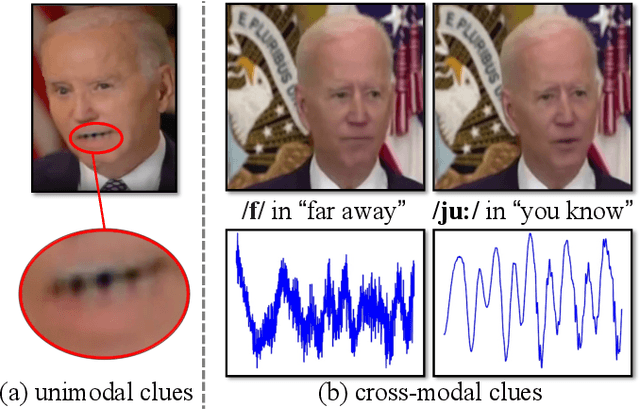

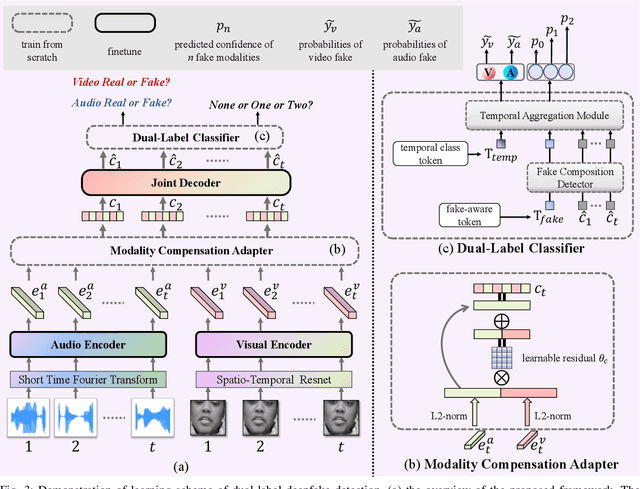
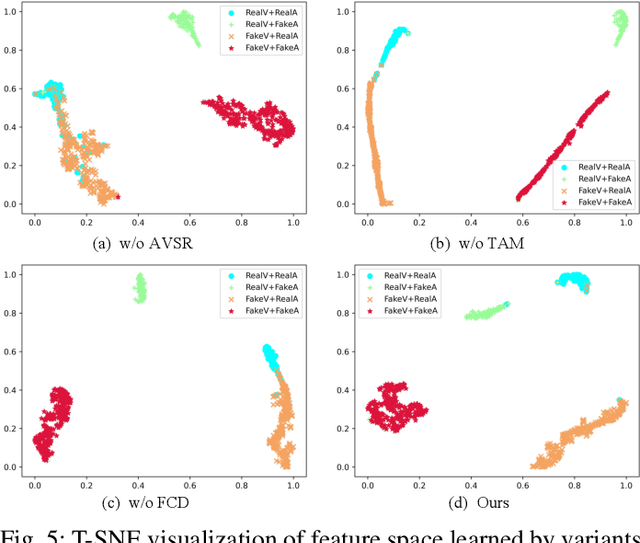
Abstract:As AI-generated content (AIGC) thrives, Deepfakes have expanded from single-modality falsification to cross-modal fake content creation, where either audio or visual components can be manipulated. While using two unimodal detectors can detect audio-visual deepfakes, cross-modal forgery clues could be overlooked. Existing multimodal deepfake detection methods typically establish correspondence between the audio and visual modalities for binary real/fake classification, and require the co-occurrence of both modalities. However, in real-world multi-modal applications, missing modality scenarios may occur where either modality is unavailable. In such cases, audio-visual detection methods are less practical than two independent unimodal methods. Consequently, the detector can not always obtain the number or type of manipulated modalities beforehand, necessitating a fake-modality-agnostic audio-visual detector. In this work, we propose a unified fake-modality-agnostic scenarios framework that enables the detection of multimodal deepfakes and handles missing modalities cases, no matter the manipulation hidden in audio, video, or even cross-modal forms. To enhance the modeling of cross-modal forgery clues, we choose audio-visual speech recognition (AVSR) as a preceding task, which effectively extracts speech correlation across modalities, which is difficult for deepfakes to reproduce. Additionally, we propose a dual-label detection approach that follows the structure of AVSR to support the independent detection of each modality. Extensive experiments show that our scheme not only outperforms other state-of-the-art binary detection methods across all three audio-visual datasets but also achieves satisfying performance on detection modality-agnostic audio/video fakes. Moreover, it even surpasses the joint use of two unimodal methods in the presence of missing modality cases.
FONT: Flow-guided One-shot Talking Head Generation with Natural Head Motions
Mar 31, 2023
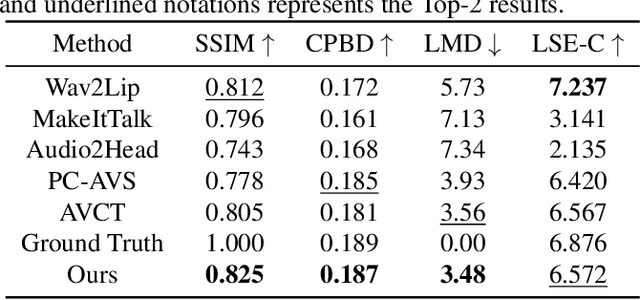
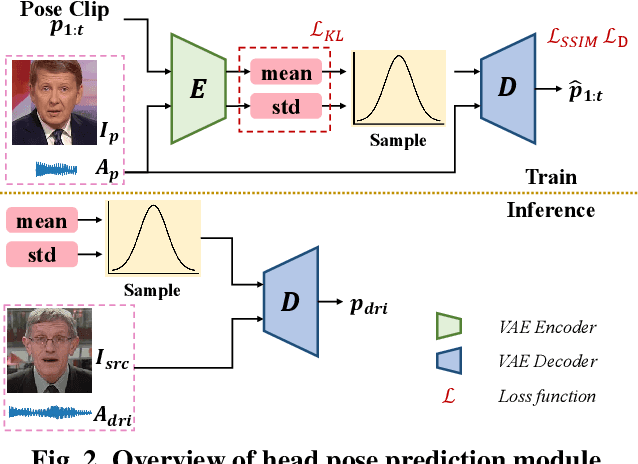

Abstract:One-shot talking head generation has received growing attention in recent years, with various creative and practical applications. An ideal natural and vivid generated talking head video should contain natural head pose changes. However, it is challenging to map head pose sequences from driving audio since there exists a natural gap between audio-visual modalities. In this work, we propose a Flow-guided One-shot model that achieves NaTural head motions(FONT) over generated talking heads. Specifically, the head pose prediction module is designed to generate head pose sequences from the source face and driving audio. We add the random sampling operation and the structural similarity constraint to model the diversity in the one-to-many mapping between audio-visual modality, thus predicting natural head poses. Then we develop a keypoint predictor that produces unsupervised keypoints from the source face, driving audio and pose sequences to describe the facial structure information. Finally, a flow-guided occlusion-aware generator is employed to produce photo-realistic talking head videos from the estimated keypoints and source face. Extensive experimental results prove that FONT generates talking heads with natural head poses and synchronized mouth shapes, outperforming other compared methods.
OPT: One-shot Pose-Controllable Talking Head Generation
Feb 16, 2023



Abstract:One-shot talking head generation produces lip-sync talking heads based on arbitrary audio and one source face. To guarantee the naturalness and realness, recent methods propose to achieve free pose control instead of simply editing mouth areas. However, existing methods do not preserve accurate identity of source face when generating head motions. To solve the identity mismatch problem and achieve high-quality free pose control, we present One-shot Pose-controllable Talking head generation network (OPT). Specifically, the Audio Feature Disentanglement Module separates content features from audios, eliminating the influence of speaker-specific information contained in arbitrary driving audios. Later, the mouth expression feature is extracted from the content feature and source face, during which the landmark loss is designed to enhance the accuracy of facial structure and identity preserving quality. Finally, to achieve free pose control, controllable head pose features from reference videos are fed into the Video Generator along with the expression feature and source face to generate new talking heads. Extensive quantitative and qualitative experimental results verify that OPT generates high-quality pose-controllable talking heads with no identity mismatch problem, outperforming previous SOTA methods.
 Add to Chrome
Add to Chrome Add to Firefox
Add to Firefox Add to Edge
Add to Edge